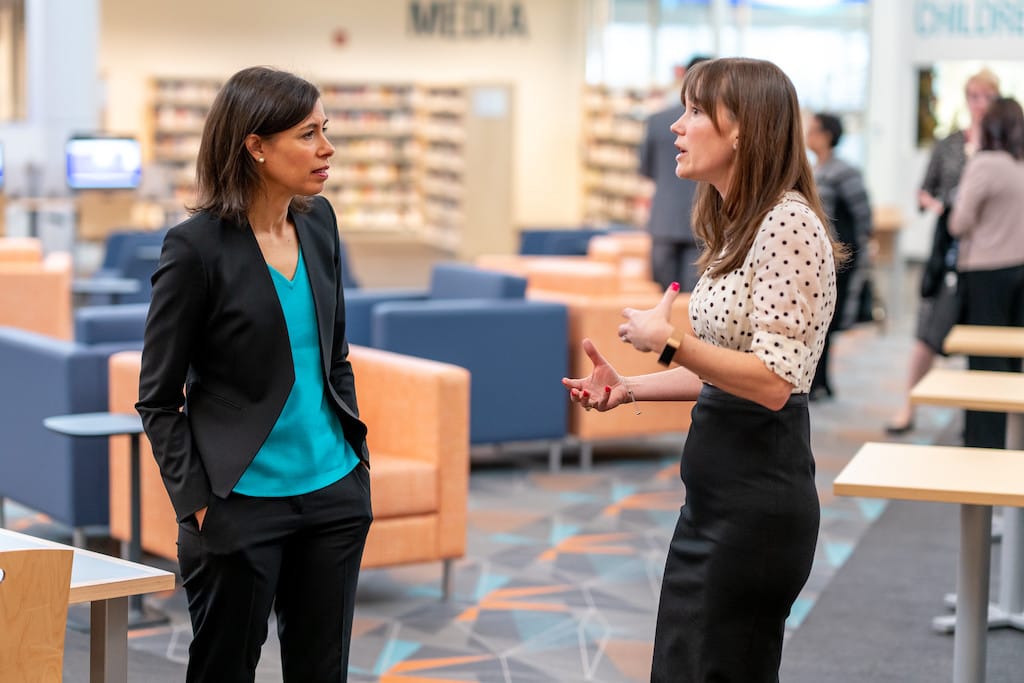Year In Review: Key Developments for Broadband’s Impact in the U.S.
This year saw a growing telehealth trend, federal digital inclusion efforts and greater attention to spectrum sharing.

WASHINGTON, December 29, 2021–High-speed internet access has never seemed more essential than in the days of another year of the COVID-19 pandemic.
And that’s why, for the third in a three-part review of 2021, Broadband Breakfast focuses on broadband’s impact in enabling benefits through expanded internet access.
Telehealth takes center stage
Because the pandemic is continually forcing closures and stay-at-home orders, the expansion of telehealth services has become a critical, normalized service this year as remote health care is a safer, more efficient way to deliver high-quality care.
Broadband service is now important to maintaining overall health––experts have defined broadband services as a social determinant of health. Expanding telemedicine across rural and Tribal communities remain barriers to better health outcomes for vulnerable populations.
The pandemic prompted Congress to extend waivers that allowed patients to take advantage of telehealth services. Experts say the waivers encouraged the growth of telehealth systems, and that investment in telehealth is necessary to improving them.
Broadband access and affordability often restrict vulnerable communities’ ability to take advantage of telehealth services. This year saw massive investments focused on funding telehealth subsidies for patients in need.
In December alone, the Federal Communications Commission announced more than $42.7 million in COVID-19 Telehealth Program awards for health care providers spending on telecommunications information services and devices. The awards also reimburse health care organizations for innovative ideas that connect patients to quality care with broadband.
For example, the Westchester County Health Care Corporation in Valhalla, New York, was awarded $1 million for the purchase of remote monitoring software and video equipment, which will allow for the creation of a “tele-ICU” for the provision of remote care for hospitalized patients.
In October, a Senate subcommittee heard testimony that permanent regulatory flexibility allowing free or subsidized telemedicine services for patients would have a positive impact on patient care. It may have a cost benefit too: FCC Commissioner Brendan Carr estimated that widespread telehealth availability could save the health care system $305 billion a year.
The FCC’s new Affordable Connectivity Fund
The Federal Communications Commission served as an accelerator to better connect communities during the pandemic through its Affordable Connectivity Program. As families and students struggled to stay connected to work and school during the pandemic, the FCC has taken historic steps to assist families can’t afford to pay for internet service and devices.
Originally established as the Emergency Broadband Benefit, the Affordable Connectivity Program is the nation’s largest broadband subsidy program to ever be enacted. The Emergency Broadband Benefit was replaced by the Affordable Connectivity Program after the passage of the Infrastructure Investment and Jobs Act in November.
The Affordable Connectivity Program transformed the Emergency Broadband Benefit into a long-term program that provides discounts for families to purchase internet service and devices. Households can also receive discounts to purchase a laptop, desktop computer, or tablet for their home.
The Affordable Connectivity Program enrollment period opens on December 31, 2021, allowing families to start the new year with the opportunity to receive new devices for the home. However, a long-standing challenge has been informing the community about these benefits. Policy experts agree that these benefit programs are not reaching the intended audience.
A November report showed that areas with low broadband adoption are less likely to enroll in the program. “If leaders want to connect the unconnected, in addition to low income groups, other programs will be needed. EBB isn’t targeting these low-adoption communities,” said Will Rinehart, senior fellow at the Center for Growth an Opportunity.
FCC Chairwoman Jessica Rosenworcel agreed on the need for emphasizing outreach. “There was no funding to help a lot of these non-profit and local organizations around the country get the word out [about the program],” Rosenworcel said during a September event hosted by the Internet Innovation Alliance about the broadband affordability divide. “And I know that it would get the word out faster if we had that opportunity.”
Digital equity and inclusion
The past year was significant for its focus on digital equity and inclusion. The closing of many public institutions because of the pandemic has forced lower-income communities into isolation without sufficient devices or technology to stay connected, digital inclusion experts say.
Organizations such as the National Digital Inclusion Association have decried a type of discrimination known as “digital redlining” in which internet service providers discriminate in broadband deployment, maintenance, upgrade, or delivery of service in lower-income neighborhoods. Because communities of color are more likely to have slower and less reliable internet service, policy leaders have been active in finding solutions.
To combat this alleged practice, Rep. Yvette Clark introduced the Anti-Digital Redlining Act on July 30. The bill finds that lower-income residents pay the same for DSL internet as fiber customers, while wealthier residents receive much better internet service. The text of the bill also acknowledges that disparities in internet access “impose significant costs” on the government to choose between “either offering non-digital means of interaction or excluding residents without access to high speed, reliable broadband access.”
If passed as federal law, the measure would require the FCC to ban digital redlining.
This year also saw the passage of digital inclusion-focused legislation as part of the recently-passed Infrastructure Investment and Jobs Act. The law allocated $2.75 billion to the Digital Equity Act, which establishes the federal definitions of digital inclusion and digital equity.
The Digital Equity Act’s two programs and three grant funds will supply money to the states in order to do digital equity work. For example, the Broadband Equity Access and Deployment program gives block grants to states for broadband infrastructure deployment and other digital inclusion activities.
Amy Huffman, policy director at the National Digital Inclusion Association, said that states are best prepared to promote digital equity for their residents. “The states are already in charge of so economic development workforce development health outcomes, etc. so they want the state to think holistically, about how they’re doing around digital equity will help them achieve their other goals.” By connecting all residents to quality devices and internet-enabled services, residents are better equipped to fully engage with the community and improve their quality of life.
Satellite broadband takes flight
Apart from the high-profile space launches this year, the broadband industry is both excited and skeptical about satellites playing a greater role.
In late 2020, the FCC voted to adopt rules making it easier for satellite providers to obtain licensing to deploy satellites faster. In February, Elon Musk’s SpaceX launched 120 Starlink broadband satellites on two February missions, bringing the total number of satellites to over 1,700.
Low Earth Orbit satellites, which can bring broadband to rural communities, could connect harder-to-reach communities faster than laying fiber. By May 2021, SpaceX announced it had over 500,000 orders for the Starlink service.
Other companies are also jumping into the satellite business: the FCC approved Boeing’s request to launch 132 satellites for its broadband internet network, and Amazon’s satellite imitative Project Kuiper partnered with Verizon in October to launch an internet service for underserved and unserved communities.
However, these massive investments didn’t come without controversy. Apart from concerns about Starlink’s capacity to deliver long-term, high quality service that complies with IIJA, public telecommunications policy leaders say the 12 GigaHertz (GHz) band, the portion of spectrum that Starlink uses for its services, should be shared with 5G operators to deliver internet to lower-income communities.
Research commissioned by RS Access in August concluded that the mid-band spectrum can be shared between 5G and satellite broadband operators and finding that the 12 GHz spectrum is “highly favorable for 5G,” and “can rapidly accelerate 5G deployment nationwide.”
Next year regulators and policymakers will continue the battle to determine who, if anyone, will have greater control over the 12 GHz band.
Will the ‘homework gap’ persist in a world of online education?
Last year’s initial COVID lockdown left many families unprepared and unconnected to devices or internet access and the “homework gap” persisted.
In fall 2021, many schools embraced a “hybrid” in-person, virtual schooling model. Around this time, Pew research found that lower-income parents were more likely to say their children did homework on a cellphone and could not complete homework because they did not have computer access at home.
Some students have been using public Wi-Fi because they could not connect reliably at home. The FCC’s Emergency Connectivity Fund was authorized to help close bring devices to students who lack them.
Originally launching in June as part of March’s American Rescue Plan Act, the FCC has committed $3.8 billion of the $7.17 billion program to provide funding for schools and libraries to buy equipment students to learn remotely.
The total amount committed to go to support 9,000 schools, 760 libraries, and 100 consortia for nearly 8.3 million connected devices and over 4.4 million broadband connections, the agency said last week in a press release. (See also Year in Review: Key Developments in Digital Infrastructure with Ramifications for Next Year.)
Last week, the FCC committed another $603 million in Emergency Connectivity funds to connect more than 1.4 million students across all 50 states.










